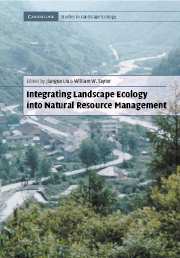Book contents
- Frontmatter
- Contents
- List of contributors
- Foreword
- Preface
- Acknowledgments
- PART I Introduction and concepts
- PART II Landscape structure and multi-scale management
- PART III Landscape function and cross-boundary management
- PART IV Landscape change and adaptive management
- PART V Landscape integrity and integrated management
- PART VI Syntheses and perspectives
- Index
- Plate Section
PART VI - Syntheses and perspectives
Published online by Cambridge University Press: 14 January 2010
- Frontmatter
- Contents
- List of contributors
- Foreword
- Preface
- Acknowledgments
- PART I Introduction and concepts
- PART II Landscape structure and multi-scale management
- PART III Landscape function and cross-boundary management
- PART IV Landscape change and adaptive management
- PART V Landscape integrity and integrated management
- PART VI Syntheses and perspectives
- Index
- Plate Section
Summary
This final section provides syntheses and perspectives regarding the interrelationships between landscape ecology and natural resource management. Although many chapters in previous sections have offered different degrees of syntheses and have touched upon various aspects of future directions, Turner et al. elevate the syntheses to an even higher level, while Odum and Forman provide foresight regarding the future of landscape ecology and natural resource management.
Turner et al. (Chapter 18) synthesize the viewpoints and findings about the spatial interrelationships among landscape elements at multiple scales and discuss the challenges in the shift toward research and management of integrated ecosystems. They then identify the causes and types of gaps between landscape ecology and natural resource management, including differences in goals, incongruities of scale, tools and methods, training and experiences of landscape ecologists and resource managers, infrastructure and data, and institutional culture. To truly integrate landscape ecology into natural resource management and use management practices as opportunities for landscape ecological research, the authors offer practical suggestions for bridging each of these gaps.
Landscape ecology traditionally has focused on scales from patches to landscapes, but Odum (Chapter 19) argues that region is a more appropriate scale for addressing many land-use and environmental problems. His argument is supported by the fact that many ecological processes occur across landscape boundaries, as demonstrated by examples in many other chapters of this book, especially those in Part III (“Landscape function and cross-boundary management”). Further, he suggests that it is necessary to have closer cooperation between academic and non-academic institutions, as well as integration between social and natural sciences at large scales.
- Type
- Chapter
- Information
- Integrating Landscape Ecology into Natural Resource Management , pp. 431 - 432Publisher: Cambridge University PressPrint publication year: 2002



